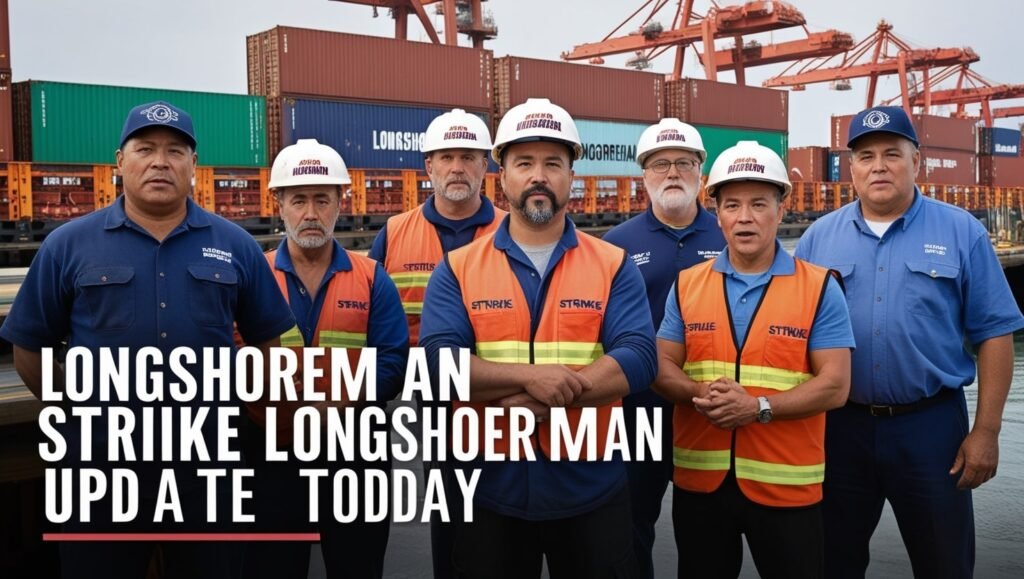Introduction To Longshoreman Strike
The Longshoreman Strike is making waves in the worldwide shipping industry, influencing not only fair ports but economies distant past. For numerous, this strike serves as a basic crossroads, where the tug-of-war between laborers and managers sheds light on greater industry-wide issues. From slowed-down cargo to postponed merchandise, the swell impacts are felt universally. But what’s behind this strike, and why ought you care? Let’s jump Profoundly into the most recent improvements, investigate the causes, and Understand how this strike impacts exchange and the more extensive economy.

Current Status of the Strike
The longshoreman strike is continuous, and as of today, it appears small sign of determination. The strike, which started a few weeks back, has as of now caused critical disturbance over different ports, especially along the West Coast of the Joined together States. Over 20 major ports have been influenced, driving delays in cargo dealing and shipping schedules.
Latest Developments:
- Ports in California, Washington, and Oregon have seen a serious lull in operations, with numerous coming to a total standstill.
- The number of longshoremen partaking in the strike has developed, with thousands denying to return to work.
- Talks between union agents and managers have slowed down, with both sides remaining dug in in their demands.
Duration of the Strike:
- The strike has presently entered its fourth week, with no clear conclusion in sight.
- Some examiners propose that without intercession, the strike might amplify well into the coming months.
Number of Ports Affected:
- Over 29 ports, basically on the U.S. West Coast, are right now encountering disruptions.
- International ports subordinate to U.S. exchange courses are moreover beginning to feel the impact.
Reasons Behind the Strike
There are a few driving powers behind the longshoreman strike, and understanding these issues is key to getting a handle on why arrangements are demonstrating so difficult.
Key Issues Provoking the Strike
Wage Disparities:
Workers are requesting higher compensation that they accept are in line with the rising toll of living. They contend that whereas shipping companies have recorded record benefits, their compensation has remained stagnant.
Safety Concerns:
Working conditions have also ended up being a point of dispute. Longshoremen are pushing for way better security conventions, particularly in light of the COVID-19 widespread, which exacerbated as of now unsafe working conditions at ports.
Job Security:
With computerization on the rise, numerous longshoremen fear that their occupations may be supplanted by machines. This has driven requests for work security ensures and retraining programs.
Stakeholder Perspectives
Workers’ Perspective:
Longshoremen contend that they are the spine of the shipping industry and that without reasonable compensation and working conditions, they will proceed to strike until their requests are met.
Employer’s Perspective:
On the other hand, managers argue that the worldwide shipping industry is confronting uncommon challenges, and the assembly of the union’s requests may strain the industry’s finances.
Government Involvement:
Governments, especially the U.S. government, are beneath the weight to step in and intercede in the transactions to avoid disturbance to the economy.

Affect on Shipping and Trade
The longshoreman strike has as of now had a far-reaching effect, particularly on shipping plans and worldwide trade.
Delays in Shipping Schedules
- Shipping lines are detailing critical delays, with a few cargo vessels being rerouted to dodge-influenced ports.
- Supply chain disturbances have influenced businesses from car to retail, causing deficiencies in different products.
Economic Suggestions for Merchants and Exporters
- Shippers and exporters are facing extended costs because of deferrals and rerouting.
- Smaller businesses, which depend intensely on convenient shipments, are especially powerless, with a few announcing extreme budgetary strain due to undelivered goods.
Effects on Neighborhood Economies
Port cities are starting to feel the impacts of the strike, as laborers in related businesses (such as trucking and warehousing) are moreover affected by the slowdown.
- Local businesses subordinate to harbor action are announcing noteworthy income losses.
Government and Union Responses
- As the strike proceeds, both the government and unions have been vocal in their stances.
Statements from Government Officials
U.S. government authorities, counting those from the Division of Labor, have communicated concern about the strike’s effect on the economy and are calling for both parties to return to the arranging table.
Some states are considering authoritative mediation, even though no formal steps have been taken yet.
Reactions from Union Leaders
Union pioneers stay enduring, expressing that they will not back down until their requests are met. They emphasize that the strike is around more than fair compensation; it’s approximately regard and nobility in the workplace.
Ongoing Arrangements or Intercession Efforts
Mediators have been brought in to encourage talks, but advance has been moderate. Both sides stay distant and separate on key issues, especially compensation and work security.
Future Outlook
- What does the future hold for the longshoreman strike and the shipping industry as a whole?
Predictions for Determination Timelines
Optimistic gauges propose that a determination might be come to inside the another few weeks, particularly if government mediation increases.
However, numerous accept the strike might amplify into the following quarter, causing indeed more disturbance to the worldwide supply chain.
Potential Long-Term Impacts on Labor Relations in the Industry
This strike seems to set a point of reference for future labor relations in the shipping industry. If the longshoremen are effective, other unions may be empowered to strike for comparable reasons, especially over computerization concerns.
Conclusion
In rundown, the longshoreman strike has highlighted critical issues inside the shipping industry, from wage incongruities to work security in the confront of mechanization. The swell impacts on worldwide exchange, nearby economies, and labor relations will as it were develop as the strike drags on. It’s clear that all stakeholders—whether specialists, bosses, or governments—must discover a way to resolve these issues rapidly and decently to anticipate and encourage disruption.
Frequently Inquired Questions (FAQs)
How long has the longshoreman strike been going on?
- The strike has entered its fourth week, zeroing in on no unquestionable confirmation.
Why are the longshoremen striking?
- The essential issues driving the strike incorporate wage debate, security concerns, and fears over work security due to expanded mechanization in the shipping industry.
Which ports are influenced by the strike?
- Over 29 ports along the U.S. West Coast are influenced, with disturbances amplifying worldwide exchange routes.
How is the government reacting to the strike?
- Government authorities are encouraging both parties to return to arrangements, and arbiters have been brought in to encourage discussions.
What is the potential long-term effect of the strike?
- If the strike proceeds, it may lead to long-term disturbances in worldwide exchange and set a point of reference for labor relations in the shipping industry, especially concerning robotization and work security.


